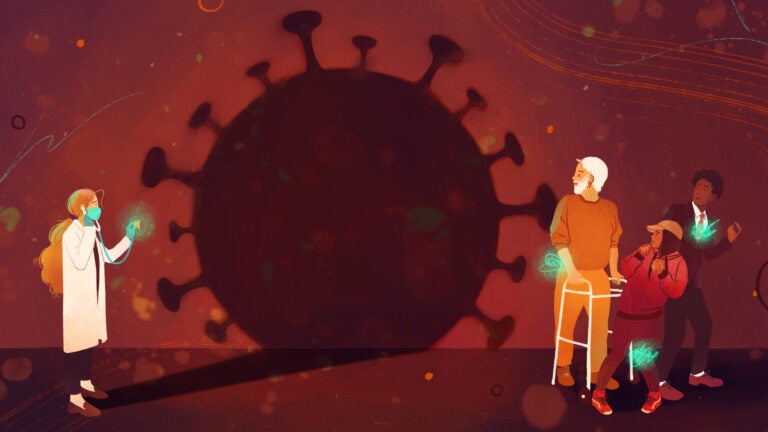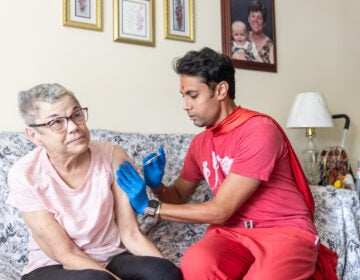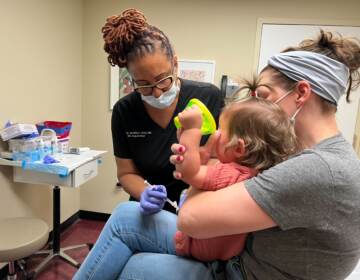5 medical appointments you should stop putting off

(Kristen Uroda for NPR)
As the medical community unearths troubling consequences for people who put off routine or emergency health care during the coronavirus pandemic, an urgent message is going out to patients: There are some medical appointments you just shouldn’t put off any longer, even if you’re nervous about venturing into a clinic or emergency room.
In the first days of the COVID-19 pandemic, I was one of many primary care doctors making tough decisions about who needed to be seen in person and who could wait a few weeks. But as weeks have turned into nearly a year, our calculus has changed.
“There was a time, early in the pandemic, when we didn’t know much about this virus. So at that time, I think hospitals and clinics closing — that made sense,” Dr. Ned Sharpless, director of the National Cancer Institute, tells NPR. “But that time is over. We can have patients come in and get these tests and see their doctors in person in a way that is both safe for the caregiver and safe for the patient, and the risk of transmission is low.”
Emerging evidence tells us that the health threats from postponing some tests and exams — including those for cancer and heart disease, but other crucial appointments too — outweigh the risk of running into the coronavirus at a doctor’s visit, even if the virus is prevalent in your community.
“A woman is more likely to die from an advanced-stage breast cancer than she is from COVID-19,” says Dr. Therese Bevers, medical director of the Cancer Prevention Center at the MD Anderson Cancer Center. Bevers says she worries that even with low COVID-19 transmission rates in health care facilities and encouragement to keep up with certain screenings and follow-up appointments, many people are still putting off those doctor visits — and suffering more as a result.
I checked in with leading physicians and put together this list of five key types of in-person medical appointments you should be sure not to skip right now.
Cancer screenings
When it comes to finding — and fighting — cancer, timing can make the difference between life and death. Routine screenings for breast cancer, colon cancer, skin cancer and other malignancies are coming due for many people now that we’ve gone nearly a year since the pandemic’s start. Procrastinators and those with health insurance disruptions may have gone even longer than a year. For some people, such as those who have a personal or family history of cancer, the need to catch up is pressing.
“People delaying their cancer screenings are being diagnosed at later, more advanced stages when treatments aren’t as successful as they are in earlier stages,” Bevers says.
She cites research published last summer from the National Cancer Institute that predicts more than 10,000 additional deaths from breast and colorectal cancer due to poor screening rates during the pandemic. The study forecasts a spike in deaths from those additional cancers within the next two years.
“We’re particularly concerned,” Sharpless says, “about people who are having, but not getting evaluated for, symptoms [of cancer] like a new breast lump or trouble swallowing, and other things like that may not be particularly worrisome to patients initially” but can signal serious illness — including cancer. So call your doctor and make an appointment to get symptoms like those checked out.
Prompt checkups for new red-flag symptoms
Maybe even riskier than skipping screening tests is ignoring new persistent symptoms of any kind — waiting until the end of the pandemic to have those symptoms checked out can give potentially dangerous conditions time to smolder and flare.
Red-flag symptoms that could signal heart disease are especially crucial to get on top of: Even in a year with more than 500,000 U.S. deaths from COVID-19 since the pandemic began, heart disease is still one of the leading causes of death in the nation, typically responsible for about 655,000 fatalities annually.
Calling 911 and getting treatment in the ER should still be the response to sudden emergency symptoms like crushing chest pain and trouble breathing. But don’t push aside a call and visit to the doctor if you have subtler symptoms such as occasional chest discomfort or shortness of breath that comes and goes or that stops if you sit down and rest.
Any new symptom that’s happening often or is affecting your daily life calls for examination by a health care provider — and it can’t wait.
Follow-ups for chronic disease
If you’re already taking medicines for a health condition, now’s not the time to avoid seeing the person who prescribed them to you. Reach out to that doctor or other health care provider now — chances are you’ll need an office visit if you haven’t had one since the pandemic started, and it may be unsafe for you to keep postponing that appointment.
That’s especially true for diagnoses such as heart failure, chronic lung and kidney diseases or diabetes — illnesses that can have serious complications if they’re not managed closely. It’s worth noting that 43% of patients with diabetes surveyed by the American Diabetes Association in December said they’ve delayed seeking routine medical care during the pandemic, often because of the fear of COVID-19.
And while some routine care gaps can be filled with virtual visits to help you manage conditions from home, there are important things that can’t be done online or by telephone — vaccinations, lab tests, wound care and other important maintenance exams, for example, that are vital for patients who have a chronic illness.
“This is no longer a couple of months’ delay here, and it is too long a time to go without the right care,” says Dr. Robert Gabbay, an endocrinologist and the chief science and medical officer of the American Diabetes Association. He warns of the long-term problems that can outrun treatment if caught too late.
“The complications of diabetes — eye disease, kidney disease, nerve damage — is really all about diagnosing people early to then intervene to ensure that things don’t get worse,” Gabbay tells NPR. “So people could be having very active disease, not knowing, and this is a real concern.”
Many chronic diseases put patients at greater risk of dying from COVID-19 too. That’s particularly true if the condition isn’t under control.
Mental health management
Just as the pandemic has put extra stress on those suffering from physical ailments, it has taken a toll on people with mental health problems. Though many health care providers have expanded virtual options for getting mental health and substance abuse treatment in the U.S., we’re still seeing high rates of drug overdose and emergency room visits for mental health crises.
Don’t let the pandemic lead you to postpone psychiatric appointments, including those that require in-person interactions. Regular visits for long-acting psychiatric drug injections, for example, or for drug screening tests and medicine pickups for patients in medication-assisted treatment programs need to continue uninterrupted. And blood tests for medicine titrations should also be kept up to date.
Of special note: Anyone experiencing suicidal thoughts may need prompt attention from a health care professional. If you or someone you know may be considering suicide or if you don’t feel confident about helping someone through a crisis period, contact the National Suicide Prevention Lifeline at 1-800-273-8255.
“We’ve been dealing with COVID-19 for a while, and people are starting to suffer some consequences of it — adopting less healthy behaviors, engaging in risky [substance use] or feeling depressed, anxious or stressed,” says Dr. Alex Krist, a family physician and chairperson of the U.S. Preventive Services Task Force. Such symptoms “have had more time to compound and get worse for people delaying care,” Krist says.
It’s not just people with prior mental health diagnoses who need care right now, says Krist. Given the ongoing stresses of the pandemic, many people have experienced symptoms of anxiety or depression for the first time this past year. And new diagnoses of mental illness can often fall through the cracks when patients skip primary care appointments, so be aware of common symptoms.
If you or a loved one has experienced psychiatric or substance use problems for the first time during the pandemic, the best time to get help is now. You and your health care provider may decide the problem can be safely treated via telehealth appointments, but inpatient treatment programs and behavioral health hospitals are still open during the pandemic — and in certain cases that’s the best option.
Whether your mental health symptoms are new or long-standing, talk over your concerns with a professional, Krist advises. Do that early and often, and make plans for how you’ll follow up with the professional to help avoid a crisis in the future.
Sexual health maintenance
The most recent data about sexually transmitted diseases from the Centers for Disease Control and Prevention indicate that, even in the pre-pandemic era, an estimated 1 in 5 Americans had an STD on any given day. We don’t know exactly how the pandemic has affected that number, but we do know that sexually transmitted infections are continuing to spread.
Some STDs are curable, and most are at least treatable. Without treatment, several types can cause severe, life-threatening illness or even affect fertility down the road, so getting prompt treatment is crucial.
Unfortunately, pandemic fears and restrictions have made it more difficult for patients to get tested and treated for STDs. A shortage in routine testing supplies and a drop in the number of available clinic visits for testing are partly to blame.
It’s as important as ever to talk to a health care provider about how to manage your sexual health. The provider may decide it’s safe to wait on STD testing, based on your individual health history. On the other hand, they may recommend an appointment to come in for testing — and that’s a test you don’t want to miss.
If you’ve got new genital or urinary symptoms or think you’ve been exposed to a sexually transmitted infection, holding out for the pandemic’s end is not an option. That’s also the case for patients who are taking medicines to treat or prevent HIV — preventive medications called preexposure prophylaxis, or PrEP — so regular visits for the required lab tests that ensure the treatment’s safety should be prioritized.
The same rules apply for some birth control methods. Long-acting birth control devices, such as intrauterine devices (IUDs) and other implants, have expiration dates. If you’re using one of these methods, do check with your health provider to see if you’re close to that date — and don’t delay an appointment if the device needs to be replaced.
Don’t let fear ruin your health
We’re in the fight of our lives against the spread of COVID-19, but other health risks haven’t gone away. If anything, they’ve gripped us even tighter during our distraction. That means now is the time to, at a minimum, check in with your health care provider about any appointments you might need.
Be honest with your provider about your symptoms and fears. It’s perfectly acceptable to ask how they’re keeping patients safe from the coronavirus in their facilities or mention that you’re still really scared to come in. Either way, don’t let another day pass without letting a professional help you decide which symptoms can or shouldn’t wait to be evaluated: That conversation could save your life.
“People need to do what they feel safe doing, but they can be interacting with and getting help from their doctor in safe ways right now,” Krist says. “To think about just putting your health on hold — that’s a mistake.”
Dr. Kristen Kendrick is a board-certified family physician in Washington, D.C., and a health and media fellow at NPR and Georgetown University School of Medicine.
9(MDAzMzI1ODY3MDEyMzkzOTE3NjIxNDg3MQ001))


![CoronavirusPandemic_1024x512[1]](https://whyy.org/wp-content/uploads/2020/03/CoronavirusPandemic_1024x5121-300x150.jpg)


